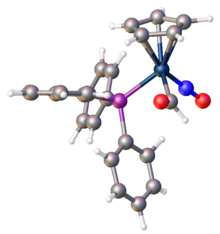
In organometallic chemistry, a transition metal formyl complex is a metal complex containing one (usually) or more formyl (CHO) ligand. A subset of transition metal acyl complexes, formyl complexes can be viewed as metalla-aldehydes. A representative example is (CO)5ReCHO. The formyl is viewed as an X (pseudohalide) ligand. Metal formyls are proposed as intermediates in the hydrogenation of carbon monoxide, as occurs in the Fischer-Tropsch process.
Structure and bonding
The MCHO group is planar. A C=O double bond is indicated by X-ray crystallography. A second resonance structure has a M=C double bond, with negative charge on oxygen.
Synthesis and reactions
Metal formyl complexes are often prepared by the reaction of metal carbonyls with hydride reagents:
- + H → (CO)5ReCHO
The CO ligand is the electrophile and the hydride (provided typically from a borohydride) is the nucleophile.
Some metal formyls are produced by reaction of metal carbonyl anions with reagents that donate the equivalent of a formyl cation, such a mixed formate anhydrides.
Metal formyls participate in many reactions, many of which are motivated by interest in Fischer-Tropsch chemistry. O-alkylation gives carbenoid complexes. The formyl ligand also functions as a base, allowing the formation of M-CH=O-M' linkages. Decarbonylation leads to de-insertion of the carbonyl, yielding hydride complexes.
References
- Wong, Wai-Kwok; Tam, Wilson; Strouse, C. E.; Gladysz, J. A. (1979). "X-Ray crystal structure and chemical transformations of the neutral metal formyl [(η-C5H5)Re(PPh3)(NO)(CHO)]". J. Chem. Soc., Chem. Commun. (12): 530–532. doi:10.1039/C39790000530.
- ^ Gladysz, J.A. (1982). Transition Metal Formyl Complexes. Advances in Organometallic Chemistry. Vol. 20. pp. 1–38. doi:10.1016/S0065-3055(08)60519-5. ISBN 9780120311200.
- Maity, Ayan; Teets, Thomas S. (2016). "Main Group Lewis Acid-Mediated Transformations of Transition-Metal Hydride Complexes". Chemical Reviews. 116 (15): 8873–8911. doi:10.1021/acs.chemrev.6b00034. PMID 27164024.
- Collman, J. P.; Winter, S. R. (1973). "Isolation and Characterization of a Kinetically Stable transition Metal Formyl complex". Journal of the American Chemical Society. 95 (12): 4089–4090. doi:10.1021/ja00793a066.
- Chen, Zilu; Schmalle, Helmut W.; Fox, Thomas; Berke, Heinz (2005). "Insertion Reactions of Hydridonitrosyltetrakis(trimethylphosphine) Tungsten(0)". Dalton Transactions (3): 580–587. doi:10.1039/b414943b. PMID 15672204.
| Coordination complexes | |
|---|---|
| H donors: | |
| B donors: | |
| C donors: | |
| Si donors: | |
| N donors: | |
| P donors: | |
| O donors: | |
| S donors: | |
| Halide donors: | |